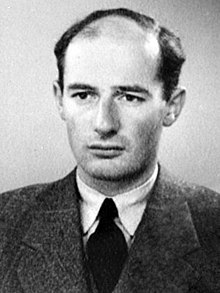Sunday, August 4th, is Raoul Wallenberg Day. Raoul Gustaf Wallenberg was a Swedish architect, businessman, and diplomat. Born on August 4, 1912, in Lidingö, Sweden, we remember and honor him for saving tens of thousands of Jews in Nazi-occupied Hungary toward the end of World War II.

Raoul Wallenberg was the grandson of Gustav Wallenberg who served as diplomat and envoy to Tokyo, Istanbul, and Sofia. Raoul’s father died of cancer three months before Raoul was born, and his maternal grandmother died three months after his birth. Raoul studied in Paris for a year before heading to the University of Michigan to study architecture. Although the family was well-heeled, he worked at odd jobs such as rickshaw handler at Chicago’s
Century of Progress at the 1933-34 World’s Fair. He also hitchhiked the U.S., telling his grandfather he felt that hitchhiking provided training in diplomacy and tact.
Wallenberg was proudly 1/16 Jewish (his maternal grandmother’s grandfather Michael Benedicks was Jewish and moved to Stockholm in 1780). Upon graduation he returned in 1935 to Sweden, but found his degree did not qualify him to practice there as an architect. His grandfather sent him to Cape Town, where he sold building materials for a Swedish firm. After six months, his grandfather found him a job at a Dutch bank in Haifa. In Palestine he first met Jews who had escaped fascism.
Wallenberg was introduced to Koloman Lauer, a Hungarian Jew, who would soon be restricted in travel after the rise of Hitler. Wallenberg hired on in Lauer’s firm, filled in for Lauer internationally, and soon became a joint owner and international director of the Mid-European Trading Company. He traveled France and Germany (Nazi controlled countries at the time) and learned how the German government functioned. In 1944, the U.S. War Refugee Board (created to save Jews from Nazis) sent to Sweden to find a Swedish delegate to send to Hungary. The conference of prominent Jews included Lauer, who suggested Wallenberg. Though he was young and relatively inexperienced, they finally approved his appointment. Wallenberg was emphatic about having carte blanche in his dealings, which request reached the highest levels and the Swedish prime minister and king both ultimately approved the demands.
By July 1944, the Germans had already deported more than 400,000 Jews from Hungary on 148 freight trains since May. That left 230,000 of a population once numbering 700,000. Both the German Nazis and the Hungarian Fascists were after Jews who were seeking any means possible of escape. Wallenberg started issuing protective papers, making them flashy, colorful, and ultra-official-looking, to protect some 4,500 persons, and he also protectively employed Jews in his offices. It was not, however, clear sailing. Upping his game by building 15,000 “Swedish houses” to secretly house Jews, by example he led diplomats from other countries also to provide protection.
On January 17, 1945, Budapest was under siege by the Red Army, and Wallenberg was detained by Russian counterintelligence on suspicion of espionage. He disappeared under mysterious circumstances, years later to be reported dead as of July 17, 1947, while imprisoned by the KGB in Moscow, though there is some evidence he was still alive later.
In 1981, U.S. Congressman Tom Lantos, saved by Wallenberg, sponsored a bill making him an honorary citizen of the United States, the second person ever to receive that honor (first was Winston Churchill). He is also an honorary citizen of Canada, Hungary, Australia, and Israel. Israel has designated Wallenberg one of the Righteous Among Nations.
Raoul Wallenberg was probably executed, though Russian claims remain unsubstantiated and his fate remains unknown.